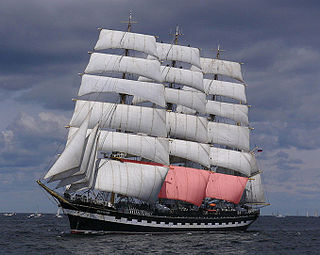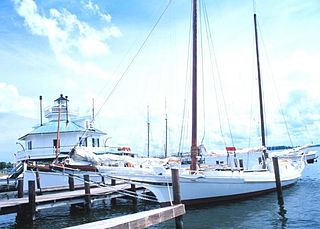
A sail plan is a description of the specific ways that a sailing craft is rigged. Also, the term "sail plan" is a graphic depiction of the arrangement of the sails for a given sailing craft.
A jib is a triangular sail that sets ahead of the foremast of a sailing vessel. Its tack is fixed to the bowsprit, to the bows, or to the deck between the bowsprit and the foremost mast. Jibs and spinnakers are the two main types of headsails on a modern boat.

A jibe (US) or gybe (Britain) is a sailing maneuver whereby a sailing vessel reaching downwind turns its stern through the wind, which then exerts its force from the opposite side of the vessel. For square-rigged ships, this maneuver is called wearing ship.

A spinnaker is a sail designed specifically for sailing off the wind from a reaching course to a downwind, i.e. with the wind 90–180° off bow. The spinnaker fills with wind and balloons out in front of the boat when it is deployed, called flying. It is constructed of lightweight fabric, usually nylon, and is often brightly colored. It may be optimised for a particular range of wind angles, as either a reaching or a running spinnaker, by the shaping of the panels and seams.

A mainsail is a sail rigged on the main mast of a sailing vessel.

Gaff rig is a sailing rig in which the sail is four-cornered, fore-and-aft rigged, controlled at its peak and, usually, its entire head by a spar (pole) called the gaff. Because of the size and shape of the sail, a gaff rig will have running backstays rather than permanent backstays.

Running rigging is the rigging of a sailing vessel that is used for raising, lowering, shaping and controlling the sails on a sailing vessel—as opposed to the standing rigging, which supports the mast and bowsprit. Running rigging varies between vessels that are rigged fore and aft and those that are square-rigged.

A Bermuda rig, Bermudian rig, or Marconi rig is a configuration of mast and rigging for a type of sailboat and is the typical configuration for most modern sailboats. This configuration was developed in Bermuda in the 1600s; the term Marconi, a reference to the inventor of the radio, Guglielmo Marconi, became associated with this configuration in the early 1900s because the wires that stabilize the mast of a Bermuda rig reminded observers of the wires on early radio masts.

Sail components include the features that define a sail's shape and function, plus its constituent parts from which it is manufactured. A sail may be classified in a variety of ways, including by its orientation to the vessel and its shape,. Sails are typically constructed out of flexible material that is shaped by various means, while in use, to offer an appropriate airfoil, according to the strength and apparent direction of the wind. A variety of features and fittings allow the sail to be attached to lines and spars.

The spritsail is a four-sided, fore-and-aft sail that is supported at its highest points by the mast and a diagonally running spar known as the sprit. The foot of the sail can be stretched by a boom or held loose-footed just by its sheets. A spritsail has four corners: the throat, peak, clew, and tack. The Spritsail can also be used to describe a rig that uses a spritsail.

The skipjack is a traditional fishing boat used on the Chesapeake Bay for oyster dredging. It is a sailboat which succeeded the bugeye as the chief oystering boat on the bay, and it remains in service due to laws restricting the use of powerboats in the Maryland state oyster fishery.

The 3000 is a racing sailing dinghy crewed by two persons with a trapeze for the crew. Launched in 1996 as the Laser 3000, the 3000 was developed from the Laser 2, using the original Frank Bethwaite-designed planing hull combined with a new designed self-draining deck by Derek Clark. Clark also re-designed the rig, using spars and sails from premium proprietary sources and replacing the symmetric spinnaker of the Laser 2 by a larger asymmetric spinnaker (gennaker). The gennaker is chute-launched and retrieved using a single halyard line, and is set on a retractable bowsprit. Helm balance and handling were improved using a shorter-footed mainsail with two full-width battens giving a larger roach. A mast with conventional spreaders replaced the now-unusual diamond arrangement of the Laser 2.

The Bermuda Fitted Dinghy is a type of racing-dedicated sail boat used for competitions between the yacht clubs of Bermuda. Although the class has only existed for about 130 years, the boats are a continuance of a tradition of boat and ship design in Bermuda that stretches back to the earliest decades of the 17th century.
An asymmetrical spinnaker is a sail used when sailing downwind. Also known as an "asym", "aspin", or "A-sail" it can be described as a cross between a genoa jib and a spinnaker. It is asymmetric like a genoa, but, the asymmetrical spinnaker is not attached to the forestay over the full length of its luff, being rigged like a spinnaker. The asymmetrical spinnaker has a larger camber than a genoa, making it optimal for generating lift at larger angles of attack, but the camber is significantly less than that of a spinnaker.

The bugeye is a type of sailboat developed in the Chesapeake Bay for oyster dredging. The predecessor of the skipjack, it was superseded by the latter as oyster harvests dropped.

The Edna E. Lockwood is a Chesapeake Bay bugeye, the last working oyster boat of her kind. She is located at the Chesapeake Bay Maritime Museum in Saint Michaels, Maryland. She was built in 1889 at Tilghman Island, Maryland by John B. Harrison and is of nine-log construction, similar to the smaller log canoe, and was launched on October 5, 1889 for Daniel Haddaway, at a cost of $2,200. She worked for at least seven sets of owners from 1899 until 1967, and was then sailed as a yacht until donated to the museum in 1973. The museum undertook an extensive restoration of the Lockwood from 1975 through 1979, which restored the bugeye to its 1910 appearance with the "patent stern" that had been added sometime prior to that year. She is the last bugeye retaining the sailing rig and working appearance of the type. Her length is 53.5 feet (16.3 m), with a 15.25 feet (4.65 m) beam and a draft of 2.58 feet (0.79 m) with the centerboard up, and a maximum sail area of approximately 1700 square feet.

The Rebecca T. Ruark is a Chesapeake Bay skipjack built at Taylor's Island, Maryland. She is homeported at Tilghman Island, Maryland. Built in 1896, she is the oldest surviving skipjack in the Chesapeake Bay fleet. She was designated a National Historic Landmark in 2003.

A jibboom is a spar used to extend the length of a bowsprit on sailing ships. It can itself be extended further by a flying jib-boom. The heel end of the flying jib-boom is attached to the jib-boom, and the heel of the jib-boom to the bowsprit. The point of the flying jib-boom is generally the fore-most extent of a ship. The jib- and flying jib- booms carry the tacks of the jib and flying jib sails, respectively, and the stay for the fore topgallant mast and the royal stay.

A sail is a tensile structure—made from fabric or other membrane materials—that uses wind power to propel sailing craft, including sailing ships, sailboats, windsurfers, ice boats, and even sail-powered land vehicles. Sails may be made from a combination of woven materials—including canvas or polyester cloth, laminated membranes or bonded filaments—usually in a three- or four-sided shape.
The following outline is provided as an overview of and topical guide to sailing:




















